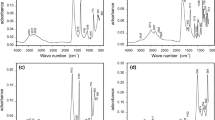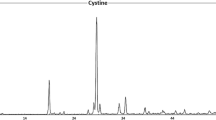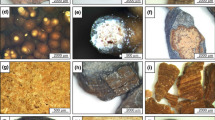Abstract
Owing to the importance of urinary stones as one of the biominerals in the human body, it is necessary to investigate their chemical composition and mineralogy. In this matter, a mineralogical study using X-ray diffraction and scanning electron microscopy indicated that urinary stones in Lorestan Province were divided into 5 groups of calcium oxalate, urate, cysteine, phosphate and mixed stones (Whewellite, uric acid, phosphate). In this regard, the microscopic studies revealed that Whewellite was the most important mineral phase among various phases. In the following, the major and rare elements of each group were determined by inductively coupled plasma mass spectrometry (ICP-MS) and X-ray fluorescence analysis. The obtained results demonstrated that Ca was found the most abundant element in urinary stones. In the analysis results of the major oxides, compared to other major oxides, CaO had the highest frequency in urinary stones. The reason was due to the role of calcium in most of the basic functions in cell metabolism. The average values of isotope 13C and 16O in the studied urinary stones were obtained − 33.71 and − 20.57, respectively. Overall, the values of 13C isotope in urinary stones were lower than those in the similar stones and human hard tissues in other countries.









Similar content being viewed by others
Data availability
Not applicable.
References
Abboud, I. A. (2008). Mineralogy and chemistry of urinary stones: patients from North Jordan. Environmental Geochemistry Health, 30(5), 445–463. https://doi.org/10.1007/s10653-007-9128-7
Abboud, I. A. (2008). Analyzing correlation coefficients of the concentrations of trace elements in urinary stones. Jordan Journal of Earth Environmental Science, 1(2), 73–80.
Abboud, I. A. (2008). Concentration effect of trace metals in Jordanian patients of urinary calculi. Environmental Geochemistry and Health, 30(1), 11–20. https://doi.org/10.1007/s10653-007-9103-3
Afaj, A. H., & Sultan, M. A. (2005). Mineralogical composition of the urinary stones from different provinces in Iraq. Scientific World Journal, 5, 24–38. https://doi.org/10.1100/tsw.2005.2
Akoudad, S., Szklo, M., McAdams, M. A., Fulop, T., Anderson, C. A. M., Coresh, J., & Kottgen, A. (2010). Correlates of kidney stone disease differ by race in a multi-ethnic middle-aged population: The ARIC study. Preventive Medicine, 51(5), 416–420. https://doi.org/10.1016/j.ypmed.2010.08.011
Al-Eisa, A. A., Al-Hunayyan, A., & Gupta, R. (2002). Pediatric urolithiasis in Kuwait. International Urology and Nephrology, 33(1), 3–6. https://doi.org/10.1023/a:1014419830292
Ancharov, A. I., Nizovskii, A. I., Gridnev, S. A., Feofilov, I. V., & Vichkanov, A. N. (2005). An attempt of in vivo X-ray diffraction analysis of kidney stones with the use of synchrotron radiation". Nuclear Instruments Methods Physics Research, 543(1), 302–305. https://doi.org/10.1016/j.nima.2005.01.245
Atakan, I. H., Kaplan, M., Seren, G., Aktoz, T., Gül, H., & Inci, O. (2007). Serum, urinary and stone zinc, iron, magnesium and copper levels in idiopathic calcium oxalate stone patients. International Urology and Nephrology, 39(2), 351–356. https://doi.org/10.1007/s11255-006-9050-4
Atan, L., Andreoni, C., Ortiz, V., Silva, E. K., Pitta, R., Atan, F., & Srougi, M. (2005). High kidney stone risk in men working in steel industry at hot temperatures. Urology, 65(5), 858–861. https://doi.org/10.1016/j.urology.2004.11.048
Athanasiadou, D., Godelitsas, A., Sokaras, D., Karydas, A. G., Dotsika, E., & Xanthos, S. (2017). New Insights into the chemical and isotopic composition of human body biominerals II: COM kidney stones from Greece. International Archives Urology and Complication, 3, 1–20. https://doi.org/10.23937/2469-5742/1510020
Ayliffe, L. K., Cerling, T. E., Robinson, T., West, A. G., Sponheimer, M., & Passey, B. H. (2004). Turnover of carbon isotopes in tail hair and breath CO2 of horses fed an isotopically varied diet. Oecologia, 139(1), 11–22. https://doi.org/10.1007/s00442-003-1479-x
Basiri, A., Shakhssalim, N., Ghahestani, S. M., & Basiri, H. (2010). The demographic profile of urolithiasis in Iran: a nationwide epidemiologic study. International Urology and Nephrology, 42(1), 119–126. https://doi.org/10.1007/s11255-009-9588-z
Basiri, A., Shakhssalim, N., Khoshdel, A. R., Ghahestani, S. M., & Basiri, H. (2010). The demographic profile of urolithiasis in Iran: a nationwide epidemiologic study. International Urology Nephrology, 42(1), 119–126. https://doi.org/10.1007/s11255-009-9588-z
Bazin, D., Chevallier, P., Matzen, G., Jungers, P., & Daudon, M. (2007). Heavy elements in urinary stones. Urological Research., 35(4), 179–184. https://doi.org/10.1007/s00240-0070099-z
Becker, G. (2007). Uric acid stones. Nephrology, 12, S21–S25.
Bellizzi, V., Nicola De, L., Minutolo, R., Russo, D., Cianciaruso, B., & Andreucci, M. (1998). Effects of water hardness on urinary risk factors for kidney stones in patients with idiopathic nephrolithiasis. Nephron, 81, 66–70. https://doi.org/10.1159/000046301
Cerling, T. E., Wittemyer, G., Rasmussen, H. B., Vollrath, F., Cerling, C. E., & Robinson, T. J. (2006). Stable isotopes in elephant hair document migration patterns and diet changes. Proceedings of the National Academy of Sciences of the United States of America, 103(2), 371–373. https://doi.org/10.1073/pnas.0509606102
Chandrajith, R., Wijewardana, G., Dissanayake, C. B., & Abeygunasekara, A. (2006). Biomineralogy of human urinary calculi (kidney stones) from some geographic regions of Sri Lanka. Environmental Geochemistry and Health, 28(4), 393–399. https://doi.org/10.1007/s10653-006-9048-y
Chandrajith, R., Weerasingha, A., Premaratne, K. M., Gamage, D., Abeygunasekera, A. M., Joachimski, M. M., & Senaratne, A. (2019). Mineralogical, compositional and isotope characterization of human kidney stones (urolithiasis) in a Sri Lankan population. Environmental Geochemistry and Health, 41(5), 1881–1894. https://doi.org/10.1007/s10653-018-0237-2
Daudon, M., Bader, C. A., & Jungers, P. (1993). Urinary calculi: Review of classification methods and correlations with etiology. Scanning Microscopy, 7(3), 1081–1106.
Daudon, M., Bouzidi, H., & Bazin, D. (2010). Composition and morphology of phosphate stones and their relation with etiology. Urological Research, 38(6), 459–468. https://doi.org/10.1007/s00240-010-0320-3
Deeming, S., & Weber, C. (1977). Evaluation of hair analysis for determination of zinc status using rats. American Journal of Clinical Nutrition, 30(12), 2047–2052. https://doi.org/10.1093/ajcn/30.12.2047
Delfan, B., Kazemeini, H., & Bahmani, M. (2015). Identifying effective medicinal plants for cold in Lorestan province, West of Iran. Journal of Evidence-based Complementary Alternative Medicine, 20(3), 173–179. https://doi.org/10.1177/2F2156587214568458
Frackowiaka, A., Skibinski, P., Gawe, W., Zaczynska, E., Czarny, A., & Gancarz, R. (2010). Synthesis of glycoside derivatives of hydroxyanthraquinone with ability to dissolve and inhibit formation of crystals of calcium oxalate Potential compounds in kidney stone therapy. European Journal of Medicinal Chemistry., 45(3), 1001–1007. https://doi.org/10.1016/j.ejmech.2009.11.042
Gholami, M., Mirzaei, S., & Jomehzadeh, A. (2011). Gamma background radiation measurement in Lorestan province. Iran International Journal of Radiation Research, 9(2), 89–93.
Giannossi, M. L., & Summa, V. (2013). An observation on the composition of urinary calculi: environmental influence. Medical Geochemistry (pp. 67–90). Dordrecht: Springer. https://doi.org/10.1007/978-94-007-4372-4_5
Giannossi, M. L., Mongelli, G., Tateo, F., & Summa, V. (2012). Mineralogical and morphological investigation of kidney stones of a Mediterranean region (Basilicata, Italy). Journal X-Ray Science Technology, 20(2), 175–186. https://doi.org/10.3233/XST-2012-0327
Giannossi, M. L., Summa, V., & Mongelli, G. (2012). Trace element investigations in urinary stones: A preliminary pilot case in Basilicata (Southern Italy). Journal of Trace Elements in Medicine and Biology, 27(2), 91–97. https://doi.org/10.1016/j.jtemb.2012.09.004
Golovanova, O., Palchik, N., & Maksimova, N. A. (2006). Comparative characterization of the microelement composition of kidney stones from patients in the Novosibirsk and Omsk Regions. Chemical for sustainable development., 15(1), 55–61.
Gupta, N. P., & Kesarwani, P. (2002). Current approaches in the medical management of urolithiasis: A review article. Indian Journal of Urology, 19(1), 20.
Heiri, O., Lotter, A. F., & Lemcke, G. (2001). Loss on ignition as a method for estimating organic and carbonate content in sediments: reproducibility and comparability of results. Journal of Paleolimnology, 25, 101–110. https://doi.org/10.1023/A:1008119611481
Hesse, A. (2009). Urinary stones. In F. Lang (Ed.), Encyclopedia of molecular mechanisms of disease (pp. 2144–2147). Springer.
Hesse, A., & Sanders, G. (1988). Atlas of infrared spectra for the analysis of urinary concrements. Georg Thieme.
Hesse, A., Berg, W., Schneider, H. J., & Hienzsch, E. (1976). A contribution to the formation mechanism of calcium oxalate urinary calculi. Urological Research, 4(4), 157–160.
Hesse, A., Tiselius, H. G., & Jahnen, A. (2002).Urinary stones–diagnosis. Treatment, and prevention of recurrence (2nd ed, pp. 228). Basel: Karger.
Hoefs, J., & Armbruster, T. (1978). 13C/12C-Verha¨ltnisse in menschlichen Harnkonkrementen. Naturwissenschaften, 65(11), 586–589.
Holmes, P., James, K. A. F., & Levy, L. S. (2001). Is low-level environmental mercury exposure of concern to human health? Science of the Total Environment, 408, 171–182. https://doi.org/10.1016/j.scitotenv.2009.09.043
Joost, J., & Tessadri, R. (1986). Trace element investigations in kidney stone patients. European Urology, 13(4), 264–270.
Kerr, A., & Laing, M. (1992). Mineralogical Studies of human urinary cal cull from Natal. Environmental Geochemistry and Health, 14, 19–25. https://doi.org/10.1007/BF01783622
Keshavarzi, B., Yavarashayeri, N., Irani, D., Moore, F., Zarasvandi, A., & Salari, M. (2015). Trace elements in urinary stones: A preliminary investigation in Fars Province. Iran. Environmental Geochemistry and Health, 37(2), 377–389. https://doi.org/10.1007/s10653-014-9654-z
Keshavarzi, B., Yavar Ashayeri, N., Moore, F., Irani, D., Asadi, S., Zarasvandi, A., & Salari, M. (2016). Mineralogical composition of urinary stones and their frequency in patients: Relationship to gender and age. Minerals, 6(4), 131.
Knoll, T. (2010). Epidemiology, pathogenesis, and pathophysiology of urolithiasis. European Urology Supplements, 1, 802–806.
Kohri, K., Garside, J., & Blacklock, N. (1988). The role of magnesium in calcium oxalate urolithiasis. British Journal of Urology, 61(2), 107–115. https://doi.org/10.1111/j.1464-410x.1988.tb05057.x
Kohri, K., Kodama, M., Ishikawa, Y., Katayama, Y., Takada, M., Katoh, Y., Kataoka, K., Iguchi, M., & Kurita, T. (1989). Magnesium-to-calcium ratio in tap water, and its relationship to geological features and the incidence of calcium-containing urinary stones. Journal of Urology, 142(5), 1272–1275. https://doi.org/10.1016/s0022-5347(17)39054-7
Krouse, H. R., & Levinson, A. A. (1984). Geographical trends of carbon and sulphur isotope abundances in human kidney stones. Geochimica Cosmochimica Acta, 48(1), 187–191. https://doi.org/10.1016/0016-7037(84)90360-0
Krouse, H. R., Levinson, A. A., Piggott, D., & Ueda, A. (1987). Further stable isotope investigations of human urinary stones: Comparison with other body components. Applied Geochemistry, 2(2), 205–211.
Kuta, J., Machat, J., Benova, D., Cervenka, R., & Koristkova, T. (2012). Urinary calculia-typical source of information on mercury in human biomonitoring. Open Chemistry., 10(5), 1475–1483. https://doi.org/10.2478/s11532-012-0063-9
Levinson, A. A., Luz, B., & Kolodny, Y. (1987). Variations in oxygen isotopic compositions of human teeth and urinary stones. Applied Geochemistry, 2(4), 367–371. https://doi.org/10.1016/0883-2927(87)90021-7
Longinelli, A. (1984). Oxygen isotopes in mammal bone phosphate: A new tool for paleohydrological and paleoclimatological research? Geochimica Et Cosmochimica Acta, 48(2), 385–390. https://doi.org/10.1016/0016-7037(84)90259-X
Lowenstam, H. A., & Margulis, L. (1980). Calcium regulation and the appearance of calcareous skeletons in the fossil record. In M. Omori (Ed.), The mechanisms of biomineralization in animals and plants (pp. 289–300). WatabeN(eds) Tokai University Press.
Lowenstam, H. A., & Weiner, S. (1989). On Biomineralization. Oxford University Press.
McGrath, K. M. (2001). Probing material formation in the presence of organic and biological molecules. Advanced Material, 13(12), 989–992.
Meyer, J. L., & Angino, E. E. (1977). The role of trace metals in calcium urolithiasis. Investigative Urology, 14(5), 347–350.
Minagawa, M. (1992). Reconstruction of human diet from r13C and r15N in contemporary Japanese hair: A stochastic method for estimating multi-source contribution by double isotopic tracers. Applied Geochemistry, 7(2), 145–158.
Mohamed Farook, N. A., Mozhiyras, P., & Nalini, R. (2006). Inhibition of mineralization of urinary stone forming minerals by medicinal plants. European Journal of Chemistry, 12, 182–185. https://doi.org/10.1007/BF02867665
Munoz, J. A., & Valiente, M. (2005). Effects of trace metals on the inhibition of calcium oxalate crystallization. Urological Research, 33(4), 267–272. https://doi.org/10.1007/s00240-005-0468-4
Muñoz, J. A., López-Mesas, M., & Valiente, M. (2010). Development and validation of a simple determination of urine metabolites (oxalate, citrate, uric acid and creatinine) by capillary zone electrophoresis. Talanta, 81(1–2), 392–397.
Nardoto, G. B., Silva, S., Kendall, C., Ehleringer, J. R., Chesson, L. A., & Ferraz, E. S. B. (2006). Geographical patterns of human diet derived from stable isotope analysis of fingernails. American Journal of Physical Anthropology, 131(1), 137–146. https://doi.org/10.1002/ajpa.20409
Paolo, C., Thomas, D., & Yigal, E. (2013). Medical Geochemistry. Geological Materials and Health, 1, 7–12. https://doi.org/10.1007/978-94-007-4372-4
Perk, H., Ahmet Serel, T., Kosar, A., Deniz, N., & Sayin, A. (2002). Analysis of the trace element contents of inner nucleus and outer crust parts of urinary calculi. Urologia Internationalis, 68(4), 286–290. https://doi.org/10.1159/000058452
Qaader, D. S., Yousif, S. Y., & Mahdi, L. K. (2006). Prevalence and etiology of urinary stones in hospitalized patients in Baghdad. Eastern Mediterranean Health Journal, 12, 853–861.
Robertson, W. G., & Peacock, M. (1980). The cause of idiopathic calcium stone disease: Hypercalciuria or hyperoxaluria?. Nephron, 26(3), 105–110.
Romero, V., Akpinar, H., & Assimos, D. G. (2010). Kidney stones: A global picture of prevalence, incidence, and associated risk factors. Reviews in Urology, 12(2–3), e86.
Safarinejad, M. R. (2007). Adult urolithiasis in a population-based study in Iran: prevalence, incidence, and associated risk factors. Urological Research, 35(2), 73–82. https://doi.org/10.1007/s00240-007-0084-6
Schwartz, B. F., Schenkman, N. S., Bruce, J. E., Leslie, S. W., & Stoller, M. L. (2002). Calcium nephrolithiasis: effect of water hardness on urinary electrolytes. Urology, 60, 23–30. https://doi.org/10.1016/s0090-4295(02)01631-x
Sekkoum, K., Cheriti, A., Taleb, S., & Belboukhari, N. (2011). FTIR spectroscopic study of human urinary stones from El Bayadh district (Algeria). Arabian Journal of Chemistry, 9(3), 330–334. https://doi.org/10.1016/j.arabjc.2011.10.010
Siener, R., Jahnen, A., & Hesse, A. (2004). Influence of a mineral water rich in calcium, magnesium and bicarbonate on urine composition and the risk of calcium oxalate crystallization. European Journal of Clinical Nutrition., 58(270), 276. https://doi.org/10.1038/sj.ejcn.1601778
Simkiss, K., & Wilbur, K. M. (1989). Biomineralization: cell biology and mineral deposition (p. 92101). CA: San Diego.
Singh, V. K., Rai, A. K., Rai, P. K., & Jindal, P. K. (2009). Cross-sectional study of kidney stones by laser-induced breakdown spectroscopy. Laser Medicine Science, 24(749), 759. https://doi.org/10.1007/s10103-008-0635-2
Sobhi, N. (2006). The mineralogy and chemistry of urinary stones from the Arabian Gulf. Internet Site, 7, 11–17.
Sood, A., Qualls, C., & Schuyler, M. (2010). Leptin, adiponectin, and asthma: findings from a population-based cohort study. Annals of Allergy, Asthma & Immunology, 104(4), 355.
Talwar, I. M., Yagyik, Y., & Lal, N. (1991). Thermally stimulated polarization studies of kidney stones. Biomaterials, 12, 518–520. https://doi.org/10.1016/0142-9612(91)90152-z
Touryan, L. A., Lochhead, M. J., Marquardt, B. J., & Vogel, V. (2004). Sequential switch of biomineral crystal morphology using trivalent ions. Nature Materials, 3(4), 239–243. https://doi.org/10.1038/nmat1096
Wijayarathna, K. S. N., & Abeygunasekera, A. M. (2013). Pathogenesis of nephrolithiasis. The Journal of Urology, 31(3), 28–32. https://doi.org/10.1016/j.juro.2012.11.069
Zarasvandi, A., Heidari, M., Sadeghi, M., & Mousapoor, E. (2013). Major and trace element composition of urinary stones, Khuzestan province, Southwest Iran. Journal of Geochemical Exploration, 131, 52–58. https://doi.org/10.1016/j.gexplo.2012.08.014
Zarasvandi, A., Carranza, E. J. M., Heidari, M., & Mousapour, E. (2014). Environmental factors of urinary stones mineralogy, Khouzestan Province Iran. Journal of African Earth Sciences, 97, 368–376. https://doi.org/10.1016/j.jafrearsci.2014.04.031
Funding
No financial support has received to conduct the current study.
Author information
Authors and Affiliations
Contributions
Seadat Aghajari contributed to data acquisition, data curation and formal analysis, Ahad Nazarpour was involved in conceptualization, writing—original draft, and validation, and Sima Sabzalipour and Rozbahani contributed to data curation, formal analysis and validation.
Corresponding author
Ethics declarations
Conflicts of interest
There is no conflict of interest regarding this research and its dissemination.
Animal research
Animal was not used in this research.
Additional information
Publisher's Note
Springer Nature remains neutral with regard to jurisdictional claims in published maps and institutional affiliations.
Rights and permissions
About this article
Cite this article
Aghajari, S., Sabzalipour, S., Nazarpour, A. et al. Mineralogy, geochemistry, 13C and 16O isotopic characteristics of urinary stones in Iran, a case study of Lorestan Province. Environ Geochem Health 43, 5157–5176 (2021). https://doi.org/10.1007/s10653-021-00986-z
Received:
Accepted:
Published:
Issue Date:
DOI: https://doi.org/10.1007/s10653-021-00986-z




